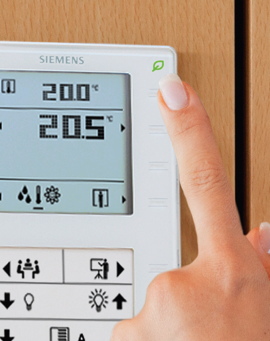Exploiting open protocols to enhance controls

Open protocols make it easy to apply quick fixes to controls. Ian Ellis of Siemens Building Technologies explains how the latest control technology is an ideal quick and affordable fix for offices where occupant comfort and efficiency need to be balanced.
When we are all left feeling a little jaded by sudden spells of hot weather, thoughts turn inevitably to the issue of comfort in offices. Of course, days that reach 30°C are rare here in the UK, and they represent the peak temperatures that our cooling systems have to deal with. However, alongside the potential for these peaks to arrive more often, is the added challenge of rising energy prices and the continued requirement to reduce UK carbon emissions.
Achieving a balance between comfort and energy efficiency is a problem that building managers have to deal with on a daily basis. Cooling, lighting and heating account for the largest energy use in offices, and they are also the most closely linked to occupant comfort.
Occupants themselves can also unintentionally sabotage energy-efficiency strategies by leaving these services operating in unoccupied spaces, or omitting to turn them off when leaving the building at night. A study by Reading University highlighted this issue, stating: ‘There is growing realisation that delivering energy-efficient buildings will require a greater appreciation of how occupants interact with their surrounding environments.’*
Controls technology can offer significant benefits by supporting FMs as they try to ensure occupants are comfortable, while maintaining energy efficiency. However, controls in many buildings may not have been set up in a way that makes this easy to do.
For example, controls for areas such as HVAC, shading and lighting may well be independent of one another. This is not a problem until you want to ensure that if window blinds are up, lighting is off. In fact, most zones such as meeting rooms have very basic functionality when it comes to controls — yet these are the places most likely to suffer from problems such as lighting and cooling being left on when the rooms are empty.
Fortunately, finding a way to co-ordinate elements of lighting, shading, heating and cooling is now much easier, because new controls technology offers much more of a quick fix than it used to. Open protocols such as BACnet and KNX make it possible to retrofit controls into a meeting room (or a number of rooms) in a way that can bring together the systems for lighting, shading and HVAC. The benefits to energy efficiency and to occupant comfort are significant.
One example of this sort of controls ‘quick fix’ is the Siemens DXR product, which has been specifically designed with this challenge in mind. It utilises the BACnet open protocol so it can be easily retrofitted into an existing building without changing the existing BEMS head-end, regardless of manufacturer.
This method of retrofitting can also be carried out on a floor-by-floor or zone-by-zone basis, reducing capital outlay. In fact, energy savings made by adding controls in one area can be re-invested to improve controls in other parts of the building.
The simple step of bringing together controls for different services in a room, also known as total room automation (TRA), lowers energy use by up to 30% and ensures that occupants are comfortable — and can’t unknowingly sabotage energy efficiency.

For example, occupants entering a meeting room in the morning may open the window blinds as it’s a sunny day. However, as the meeting room becomes warmer due to solar gain, additional cooling is required. With independent controls, what would usually happen is that the air conditioning would switch on — cooling occupants but using energy.
With the total room automation approach, what happens instead is that the blinds can be lowered to keep the space cool, while artificial lighting is introduced, but only to a level that keeps occupants comfortable. In fact, the Siemens DXR product offers a ‘red leaf’ signal on the room control panel that tells occupants the room is not operating effectively. They can press this to activate this ‘energy efficient’ approach with a single touch.
Siemens Building Technologies has carried out studies on this method of retrofitting quick-fix total room automation controls and shown real savings. For example, in a 1975-constructed office block of six floors with about 400 occupants and using fan coil units the cost of electricity and heating/cooling is around €13.8/m2 per annum. After the installation of TRA controls, this fell to €4.5/m2 per annum – giving a payback period of five years or less.
Building managers need to find quick fixes for the energy efficiency challenge, and while steps such as changing to LED lighting have proved successful, controls should be the next area in their sights. With the latest technologies based on open protocols, it does not matter what head-end or building management system is already in place in the building, better controls and greater comfort are within easy reach.
Ian Ellis is UK Marketing Manager for Siemens Building Technologies
* Source: The impact of occupant behaviour on the variation between the design and in-use energy consumption of non-domestic buildings: an experimental approach — University of Reading.







